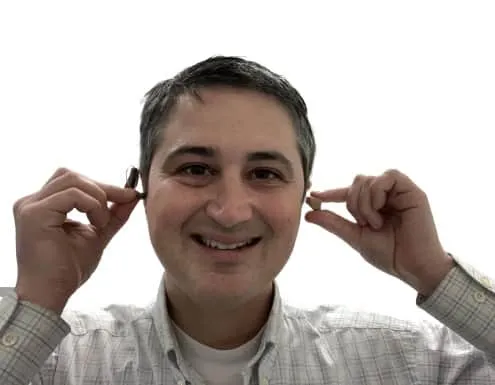Searching for a hearing aid that suits your needs depends on various factors, such as the degree of hearing loss, lifestyle preferences, and cosmetic concerns. In addition to the type and style of the hearing aid, where you purchase it is also a crucial factor.
If you opt for a professionally fitted hearing aid from a clinic, you can choose from a wide range of options and receive extensive customization from your audiologist. On the other hand, if you opt for OTC hearing aids, you will likely have fewer options and limited customization.
Two Main Hearing Aids Types
To begin with, there are two fundamental categories of hearing aids available in a variety of styles:
- In-the-ear (ITE) hearing aids
- Behind-the-ear (BTE) hearing aids also known as Receiver-In-The-Eear (RIC)
| Benefits | ITE Hearing Aids | BTE/RIC Hearing Aids |
|---|---|---|
| Size and Visibility | The smaller, more discreet size that fits inside the ear canal | Larger and more visible, but can be designed to be more inconspicuous |
| Comfort | Generally should have no issues with comfort if fits properly, but possible occlusion | Should have no issues with comfort if fits properly |
| Sound Quality | Provides excellent sound quality depending on the quality of the device | Can provide good sound quality with the use of additional features like directional microphones |
| Connectivity | May have limited or no connectivity features | Can often connect wirelessly to smartphones, TVs, remote microphones, and other devices |
| Battery Life | May have shorter battery life since they are smaller and may use smaller batteries, limited rechargeable options | Typically have longer battery life since they can accommodate larger batteries, rechargeable options |
| Durability | May be more susceptible to moisture and earwax buildup, requiring more frequent maintenance and repairs | Can be more durable since they are typically more resistant to moisture and debris. The most susceptible part (the piece inside the ear) is replaceable |
| Hearing Loss Severity | Best suited for mild to severe hearing loss | Can accommodate a wider range of hearing loss, from mild to profound |
| Popularity | 15% of the market | 85% of the market |
| Cost | about the same | about the same |
ITE Hearing aids
In-The-Ear (ITE) hearing aids are a type of hearing aid that sits inside the ear canal or bowl of the ear. These hearing aids are custom-made to fit the wearer’s ear, which provides a more comfortable and secure fit. There are OTC options that are not custom fit which may be less comfortable.
Very small ITE hearing aids are designed to be discreet and are often preferred by people who want a more subtle hearing aid option. They are often known as invisible hearing aids or Completely in the canal.
Large ITE aids are also an option that takes up the bowl of the ear. They are great for those who have dexterity issues or arthritic hands. They also have directional microphones that are better in background noise.
The parts and features of an ITE hearing aid vary depending on the manufacturer and the specific model. However, most ITE hearing aids have a similar design that includes a microphone, amplifier, and speaker. The microphone picks up sounds and sends them to the amplifier, which increases the volume of the sound. The speaker then sends the amplified sound to the ear canal.
ITE hearing aids can be designed to fit completely inside the ear canal, making them virtually invisible. Alternatively, they can be designed to sit in the lower part of the outer ear, known as the concha. These models are called In-The-Canal (ITC) hearing aids and are slightly more visible than completely-in-the-canal (CIC) hearing aids. Larger options are called Half Shell (HS) or Full Shell (FS).

Who Should Not Get ITE Devices
Most new hearing aid users have relatively good hearing in the low frequencies and poorer hearing in the high frequencies. If you wear an ITE hearing aid with good low-frequency hearing you have what is called the occlusion effect. It means that your own voice will sound echoey or hollow to you. Most people hate this effect. I would encourage you to speak with your audiologist before purchasing to know if you are likely to have occlusion.
If you buy an OTC invisible or ITE device, make sure it has a return policy so you have options if you do not like it.
BTE and RIC Hearing Aids
Both BTE hearing aids and Ric devices sit behind your ear (on top of the pinna). The names have become synonymous with each other in recent years. In previous years BTE referred to having a plastic tube that conducted the sound down into your ear canal. While a RIC would use a wire and have the speaker in the ear canal itself.
In recent years almost all behind-the-ear devices have moved away from tubing and almost all exclusively use the receiver with a wire.
Benefits of RIC hearing aids
- Comfortable to wear: RIC hearing aids are designed to be lightweight and sit comfortably behind the ear, providing a comfortable wearing experience for the wearer.
- Discreet: RIC hearing aids are smaller in size than traditional BTE hearing aids, making them a more discreet option.
- Improved sound quality: The receiver in the canal delivers sound directly to the eardrum, which can provide a more natural and improved sound quality.
- Less feedback: RIC hearing aids have less feedback than other types of hearing aids, such as BTE hearing aids.
- More flexible fitting options: RIC hearing aids come with a variety of domes and custom molds, providing more flexible fitting options for people with different ear canal sizes.
- Improved high-frequency hearing: RIC hearing aids are effective in improving high-frequency hearing loss, which is common in older adults.
- Better performance in noisy environments: RIC hearing aids come with advanced noise reduction features that help to reduce background noise, making it easier to hear in noisy environments.
- Longer battery life: Because the receiver is located outside of the main body of the hearing aid, RIC hearing aids can have longer battery life compared to other types of hearing aids.
The benefit of hearing aids that go on top of your ear is many. That is the reason why the market is dominated by the over-the-ear style. The main reasons why persons choose an in-the-ear hearing aid over a behind-the-ear hearing aid are generally one of these 3 reasons:
- Dexterity issues: ITEs are easier for those that do not have good use of their fingers or good mobility.
- Vanity: some people just truly want an invisible option that sits down inside the ear canal.
- Limited space behind ears. If you wear an oxygen cannula, glasses, and occasional COVID facemask. Aids can be pulled off when removing items.
In summary, In-the-Ear (ITE) and Behind-the-Ear (BTE) hearing aids are two of the most common types of hearing aids available in the market. BTEs are more popular but ultimately, the choice between ITE and BTE hearing aids depends on the individual’s hearing needs and preferences. Whatever manufacturer of hearing aid you choose, they likely have the same model of the device in both styles. See my recommendations for hearing aids.

